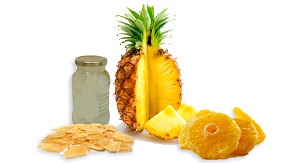 Pineapple (Ananas comosus), is the common name for a tropical plant and its edible fruit, which is actually a multiple fruit consisting of coalesced berries. The Spanish introduced it into the Philippines in the early of 19th century. Pineapple can be consumed fresh, canned or juiced and can be used in a variety of ways. It is popularly used in desserts or salads, usually tropical fruit salads, jams, yogurts, ice creams, various candies, as a complement to meat dishes and in fruit cocktail. The popularity of the pineapple is due to its sweet-sour taste. Pineapple is an excellent source of manganese and vitamin C.
Pineapple (Ananas comosus), is the common name for a tropical plant and its edible fruit, which is actually a multiple fruit consisting of coalesced berries. The Spanish introduced it into the Philippines in the early of 19th century. Pineapple can be consumed fresh, canned or juiced and can be used in a variety of ways. It is popularly used in desserts or salads, usually tropical fruit salads, jams, yogurts, ice creams, various candies, as a complement to meat dishes and in fruit cocktail. The popularity of the pineapple is due to its sweet-sour taste. Pineapple is an excellent source of manganese and vitamin C.
The productivity of pineapple does not necessarily yield good price. At harvest season, the price is very low and lots of wastes are incurred in the market place and producing centers.
To overcome this problem, a technology has been developed to process fresh pineapple into variety of food products such as Pineapple Candy, Dried Pineapple and Nata de Piña.
How to Make Pineapple Candy
Procedure:
- Weigh rare ripe pineapple. Remove the crown. Wash pineapple thoroughly in tap water.
- Soak in chlorinated water (200 ppm) for 10 minutes to reduce microbial load. Drain.
- Peel the fruits and remove the eyes and the core.
- Cut the fruits into desired thickness and shape (or cut it into wedges of about 2 cm thickness or dice it into desired size and thickness).
- Soak the fruits into hot boiled heavy syrup (1 part water: 1 part sugar) containing citric acid equivalent to 0.3% (3g/liter of syrup), and sodium benzoate, 0.1% (1g/liter of syrup). The latter is added as a precautionary measure against mold growth.
- Let the material stand overnight in a cool place.
- Drain the fruits.
- Increase the syrup concentration by 2% or more and boil.
- Cool the hot syrup slightly and re-soak the fruits.
- Repeat this operation daily for about a week or until the sugar no longer dissolves.
- Drain the syrup-impregnated fruit.
- Wipe off sticky syrup with clean moist cloth, and dry under the sun or appropriate drier until moisture content is about 30 to 35%.
- Cool. Pack and seal it in polyethylene bags, glass jars, or other appropriate containers.
How to Make Dried Pineapple
Procedure:
- Weigh rare ripe pineapple. Remove crown. Weigh. Wash pineapple thoroughly in tap water.
- Soak in chlorinated water (200 ppm)* for 10 minutes to reduce microbial load. Drain.
- Peel the fruits and remove the eyes and the core.
- Cut the fruits into wedges of about ½- to 1-inch thickness or dice it into desired size and thickness.
- Steam blanch the fruit slices for 8 minutes. Cool rapidly in running water.
- Soak the fruits into hot boiled syrup (60 parts sugar, 40 parts water). Cook it rapidly until translucent. Cool to room temperature.
- Add 0.1% sodium metabisulfite (or a combination of 0.1% sodium erythorbate and 0.1% citric acid). Soak overnight in syrup for 18-20 hours.
- Drain the syrup. Rinse the fruit slices 2 to 3 times in tap water.
- Drain thoroughly.
- Lay the fruits in trays lined with cheesecloth. Dry in cabinet drier with 60±2°C temperature for 8 to 10 hours or until dry.
- Remove the dried pineapples from the tray. Pack in ordinary plastic bags. Allow the dried pineapple to sweat overnight.
- Separate pineapple slices. Pack it in a suitable packaging material.
- Seal. Label and store in a cool dry place.
How to Make Nata de Piña
Ingredients:
- Pineapple
- glacial acetic acid
- sugar starter
Procedure:
- Mash 1 kg peeled pineapple with 12 liters water.
- Add 600 grams sugar. Boil.
- Strain in cheesecloth. Cool.
- Add 340 mL glacial acetic acid.
- Add 2 liters starter or mother liquor.
- Mix in one container.
- Transfer into sterilized wide-mouth container.
- Cover with clean paper or cheesecloth and tie around.
- Store in an area where it is not disturbed.
- Ferment/let it grow for 10 to 14 days.
- De-acetify by washing in several changes of water.
- Slice/dice nata.
- Bleach under the sun with water.
- Change water every 4 hours or boil in several changes of water.
Source: mis.dost.gov.ph